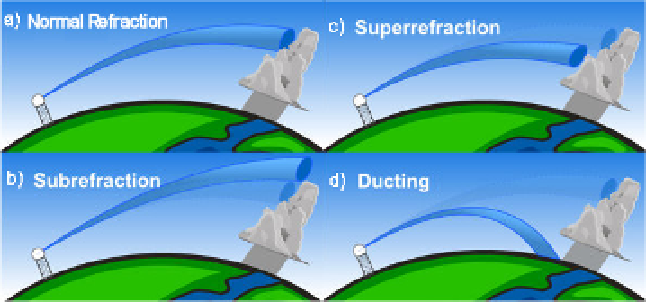Geoscience Reference
In-Depth Information
corrections and subsequent precipitation estimates. Section 5 deals with the topic of
propagation conditions forecasting and Section 6 presents a method to correct the effects of
intense anomalous propagation conditions on weather radar precipitation estimates using
satellite observations. Finally Section 7 provides a summary and concluding remarks.
2. Weather radar beam propagation conditions
This section presents qualitatively the different propagation regimes affecting the radar beam
refraction. By radar beam we mean the energy emitted (and received) by the radar, limited by
the half-power (3 dB) antenna main lobe (see Zrnic, this volume, for more details). In the
vacuum, as in any media with constant index of refraction, a radar beam follows a straight
trajectory. But in the atmosphere the index of refraction changes and therefore the variation of
the air refractive index plays a key role when characterizing the propagation conditions of a
radar beam in the troposphere, i.e. the lowest part of the atmosphere. In particular, the vertical
profiles of the air temperature, moisture and pressure are mostly responsible for the way the
radar energy will propagate in a given air layer. A number of assumptions on these vertical
profiles are usually made, assuming the so-called "standard” or normal propagation
conditions which are associated with the average state of the atmosphere accepted as the most
representative, as discussed below. Under those conditions, the radar beam bends downward
with a radius of curvature greater than that of the Earth surface. Consequently, the net effect is
an increase of the height of the centre of the beam with respect to the ground as the distance
from the radar increases (in Section 4 the equation for the radar beam height is given).
However, due to the inherent variability of the atmosphere, it is a well-known fact that
propagation conditions may differ, sometimes significantly, from those considered standard
resulting in anomalous propagation (AP). As illustrated schematically in Fig. 1,
subrefraction causes the radar beam to bend less than usual, and therefore follows a higher
trajectory than in normal conditions. Super refraction of a weather radar beam produces
more bending towards the ground surface than expected for standard conditions and
therefore increases and intensifies ground clutter echoes (AP or anaprop echoes). An
extreme case of superrefraction, known as ducting, occurs when the beam has a curvature
smaller than that of the Earth surface.
Fig. 1. Radar beam propagation conditions (adapted from US NOAA National Weather
Service, introductory radar tutorial, “Doppler radar beams”,
http://www.srh.noaa.gov/jetstream/doppler/beam_max.htm ).


